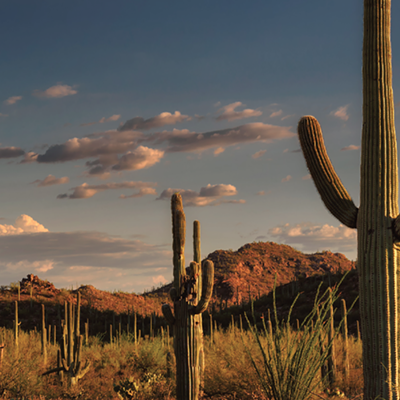At just over 70 pages, and only 8 inches square, Frank Lloyd Wright in Arizona looks more like a kid's picture book than a coffee-table tome, but it's an apt reflection of the slim but focused Arizona product of one of last century's architectural giants.
Cheek opens the book with a telling anecdote. It was 1957; Wright was 89 years old and still active. A reporter called to Wright's attention architectural plans for a proposed new state capitol building. The architect was disdainful: "Why comment?" he responded. "The thing is its own comment on Arizona." Then, after dashing off an alternative plan and throwing it in the trash, he convened his cadre of "boys"--grown-up apprentices--and, in the space of two hours, produced plans and elevations for his vision of the state's capitol. It was "an orgy of glittering spires and geometric filigree," according to Cheek, marked by "the froufrou ... of his final decade's work." If it had been built, it "would have soared high over budget," plagued the bureaucracy with "endless idiosyncrasies, and, in all probability, [have had] a leaky roof." What it was not--and this was Wright's point--was expedient.
While Cheek focuses on Wright's work, it's impossible to ignore the man's personality. "Audacious, outrageous, flamboyant, combative, mischievous, pithy, brilliant, cockamamie, and ever eager for publicity," he seemed to live life as art. Wright's personal life was huge and messy; his professional ethics were self-serving; he became close to a cult hero.
His architectural base in Spring Green, Wis.--Taliesin--housed home and office, and was fraught with tragedy and scandal. In 1914, a servant ax-murdered Wright's mistress, her two children, and four others; he then set fire to the house. Problems with women plagued Wright: When his wife finally divorced him, in 1922, he promptly married a psychotic--hardly a life- or career-advancing move. He fathered a child from another young lover, and got himself thrown in jail for adultery and illegal cross-state transport of a woman "for immoral purposes." Professionally, things were going no better. His California houses leaked, and he got into a financial bind that resulted in a 1926 bank foreclosure on Taliesin. The Depression predictably would take its toll.
In 1928, however, at nearly 60, Wright made his first trip to Arizona and immediately embraced it. The desert provided "a vast, blank canvas on which he could impose his vision," Cheek writes; "an open-air warehouse of natural forms, colors and textures that both delighted and inspired him." He had been invited by a former student to participate in developing what would become the landmark Arizona Biltmore Hotel. The extent of Wright's involvement in the design of the Biltmore is open to debate (this critic's in-house architect had been told it was all his--a misconception the Wright ego probably would not have disabused), but his influence is unmistakable.
Wright would eventually spend more than 20 winters of a remarkably productive end-of-life at Taliesin West, the Scottsdale compound built by him, his third wife, Olga Ivanovna Milanov, and their entourage, the Taliesin Fellowship. Twelve complexes or buildings Wright designed were built in Arizona. Eleven remain, and Cheek takes us through each of them.
The book highlights Wright's vision. From his early designs, which seemed to spring organically out of the landscape--Taliesin was built from boulders and sand from the land itself, and designed to complement the surrounding mountains--to his increasingly ornate later designs, they all grew out of an individual and original architectural aesthetic. Wright had an abiding respect for nature. He believed that buildings should stand in harmony with the land, not exist as foreign objects imposed upon it.
Cheek has done the interviews and research of a responsible reporter in Frank Lloyd Wright in Arizona. He has selected vibrant color photographs and evocative black-and-whites to illustrate his text; and he's told the story and mused over its significance in thoughtful, lyrical prose. It's a celebratory, desert-colorful little coffee-table essay.







